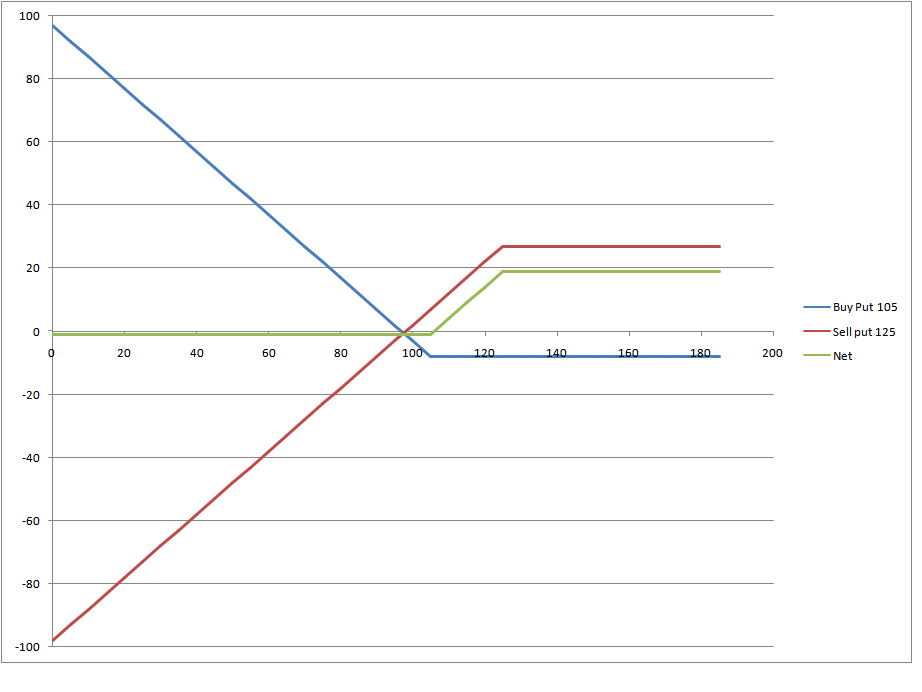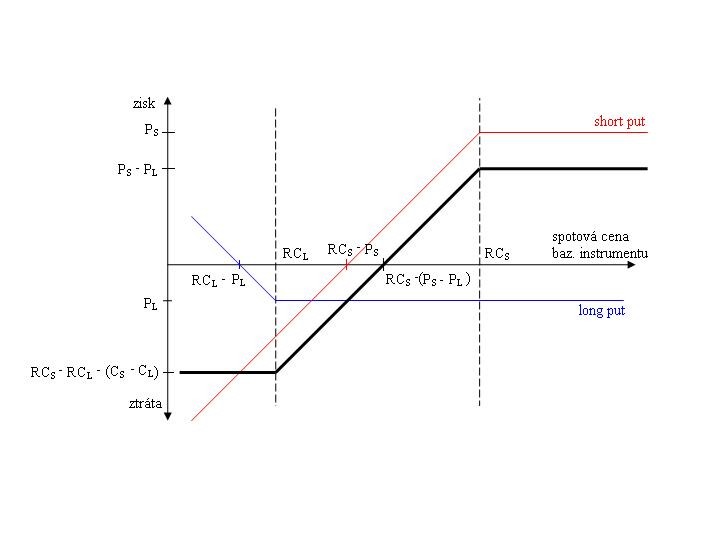What Is A Bull Put Spread
Post on: 6 Июнь, 2015 No Comment

A bull put spread is a variation of the popular put writing strategy, in which an options investor writes a put on a stock to collect premium income and perhaps buy the stock at a bargain price. A major risk of put writing is that the investor is obligated to buy the stock at the put strike price. even if the stock falls well below the strike price, resulting in the investor facing an instant and sizable loss. A bull put spread mitigates this inherent risk of put writing through the concurrent purchase of a put at a lower price, which reduces the net premium received but also lowers the risk of the short put position.
Bull Put Spread
A bull put spread involves writing or short selling a put option, and simultaneously purchasing another put option (on the same underlying asset) with the same expiration date but a lower strike price. A bull put spread is one of the four basic types of vertical spreads — the other three being the bull call spread. the bear call spread and the bear put spread. The premium received for the short put leg of a bull put spread is always more than the amount paid for the long put, which means that initiating this strategy involves receiving an upfront payment or credit. A bull put spread is, therefore, also known as a credit (put) spread or a short put spread.
Profiting from a Bull Put Spread
A bull put spread should be considered in the following situations:
- To earn premium income . This strategy is ideal when the trader or investor wishes to earn premium income, but with a lower degree of risk than through writing puts only.
- To buy a stock at a lower price . A bull put spread is a good way to buy a desired stock at an effective price that is lower than its current market price.
- To capitalize on sideways to marginally higher markets . Put writing and bull put spreads are optimal strategies for markets and stocks that are trading sideways to marginally higher. Other bullish strategies, such as buying calls or initiating bull call spreads, would not work as well in such markets.
- To generate income in choppy markets : Put writing is risky business when markets slide because of the greater risk of being assigned stocks at needlessly high prices. A bull put spread may enable puts to be written even in such markets by capping downside risk .
A hypothetical stock, Bulldozers Inc. is trading at $100. An option trader expects it to trade up to $103 in one month, and while she would like to write puts on the stock, she is concerned about its potential downside risk. The trader therefore writes three contracts of the $100 puts – trading at $3 – expiring in one month, and simultaneously buys three contracts of the $97 puts – trading at $1 – also expiring in one month.
Since each option contract represents 100 shares, the option trader’s net premium income is:
($3 x 100 x 3) – ($1 x 100 x 3) = $600
(Commissions are not included in the calculations below for the sake of simplicity.)
Consider the possible scenarios a month from now in the final minutes of trading on the option expiration date:
Scenario 1 . Bulldozers Inc. is trading at $102.
In this case, the $100 and $97 puts are both out of the money and will expire worthless.
The trader therefore gets to keep the full amount of the $600 net premium (less commissions).
A scenario where the stock trades above the strike price of the short put leg is the best possible scenario for a bull put spread.
Scenario 2 . Bulldozers Inc. is trading at $98.
In this case, the $100 put is in the money by $2, while the $97 put is out of the money and therefore worthless.
The trader therefore has two choices: (a) close the short put leg at $2, or (b) buy the stock at $98 to fulfill the obligation arising from exercising the short put.
The former course of action is preferable, since the latter would incur additional commissions.

Closing the short put leg at $2 would entail an outlay of $600 (i.e. $2 x 3 contracts x 100 shares per contract). Since the trader received a net credit of $600 when initiating the bull put spread, the overall return is $0.
The trader therefore breaks even on the trade but is out of pocket to the extent of the commissions paid.
Scenario 3 . Bulldozers Inc. is trading at $93.
In this case, the $100 put is in the money by $7, while the $97 put is in the money by $4.
The loss on this position is therefore: [($7 — $4) x 3 x 100] = $900.
But since the trader received $600 when initiating the bull put spread, the net loss = $600 — $900
= -$300 (plus commissions).
To recap, these are the key calculations associated with a bull put spread:
Maximum loss = difference between strike prices of puts (i.e. strike price of short put less strike price of long put) — net premium or credit received + commissions paid
Maximum gain = net premium or credit received — commissions paid
The maximum loss occurs when the stock trades below the strike price of the long put. Conversely, the maximum gain occurs when the stock trades above the strike price of the short put.
Breakeven = strike price of the short put — net premium or credit received
In the previous example, the breakeven point is $100 — $2 = $98.
Advantages of a Bull Put Spread
- Risk is limited to the difference between the strike prices of the short put and long put. This means that there is little risk of the position incurring large losses, as would be the case with puts written on a sliding stock or market.
- The bull put spread takes advantage of time decay, which is a very potent factor in option strategy. Since most options either expire or go unexercised, the odds are on the side of a put writer or bull put spread originator.
- The bull put spread can be tailored to one’s risk profile. A relatively conservative trader may opt for a narrow spread where the put strike prices are not very far apart, as this will reduce the maximum risk as well as the maximum potential gain of the position. An aggressive trader may prefer a wider spread to maximize gains even if it means a bigger loss should the stock decline.
- Since it is a spread strategy. a bull put spread will have lower margin requirements compared to put writes.
- Gains are limited in this option strategy and may not be enough to justify the risk of loss if the strategy does not work out.
- There is a significant risk of assignment on the short put leg before expiration, especially if the stock slides. This may result in the trader being forced to pay a price well above the current market price for a stock. This risk is greater if the difference is substantial between the strike prices of the short put and long put in the bull put spread.
- As noted earlier, a bull put spread works best in markets trading sideways to marginally higher, which means that the range of optimal market conditions for this strategy is quite limited. If markets surge, the trader would be better off buying calls or using a bull call spread; if markets plunge, the bull put spread strategy will generally be unprofitable.
The Bottom Line
The bull put spread is a suitable option strategy for generating premium income or buying stocks at effective below-market prices. However, while this strategy has limited risk, its potential for gains is also limited, which may restrict its appeal to relatively sophisticated investors and traders.














